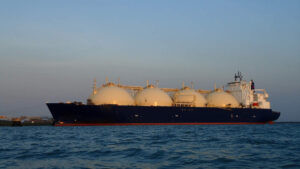Australian LNG shipments to China stay in calm waters

Pic: Matthias Kulka / The Image Bank via Getty Images
- Australia’s LNG trade with China unaffected by customs issues affecting other commodities
- ‘China is still the largest export destination for east coast LNG’ EnergyQuest
- ASX Gas Stocks: Everything you need to know
Customs restrictions affecting some commodity shipments for China have yet to impact Australian LNG shipments.
Chinese customers took delivery of 2.2 million tonnes of Australian LNG in October, slightly higher than import levels in October 2019.
September deliveries of LNG to China were 2.3 million tonnes, according to Adelaide-based consultancy EnergyQuest.
“The restrictions, so far, do not appear to have affected Australian exports of LNG to China,” said EnergyQuest in its latest report.
October-arrival Australian LNG shipments for China amounted to 31, compared with 39 delivered in September, and 30 in October 2019.
Australian LNG exports to China in the January-October 2020 period were 23.5 million tonnes and exactly the same volume for the comparative 2019 period, according to EnergyQuest estimates.
Other commodities such as coal and some agricultural foodstuffs like barley have become snagged on customs checks at Chinese ports.
Also, energy experts are grappling with Beijing’s pledge to decarbonise its economy by 2060 and its implications for carbon-intensive fuel exports.
Gladstone port sends half Australian LNG shipments to China
Australia is the largest supplier of LNG to China, and half of its shipments originate from Gladstone port in Queensland.
Gladstone port data show 1.2 million tonnes of LNG shipped to China in October, and only marginally lower than levels in October 2019 of 1.4 million tonnes.
“China is still the largest export destination for east coast LNG,” said EnergyQuest.
Eastern Australian LNG terminals shipped 12 million tonnes to China in the January-October period, representing 70 per cent of available exports.
For the corresponding 2019 period, 13.2 million tonnes of LNG went to China.
“China is heavily invested in Queensland LNG, with China’s state-run CNOOC, PetroChina and Sinopec all invested in Queensland gas projects,” said EnergyQuest.
China’s consumption of LNG imports has grown strongly this year, despite slower economic growth due to the COVID-19 pandemic.
LNG shipments of 48.2 million tonnes were delivered to Chinese customers in the January-September period, up from 43.7 million tonnes in the same period in 2019.
China to surpass Japan as the world’s largest LNG importer
Australian LNG shipments totalling 6.7 million tonnes were carried on 98 ships in October, an increase on 6.2 million tonnes on 91 ships in September.
Some 82 cargoes were shipped to the three Asian countries of Japan, Korea and China in October, up from 77 cargoes in October 2019.
The consultancy estimated that 19 Australian LNG shipments were delayed in October, after 20 September cargoes suffered delays, and in August the number of delayed shipments was 35.
“Cargo delays continued to subside in October and delay times were reduced compared to those seen over the last few months,” said EnergyQuest.
Japan imported 54.7 million tonnes of LNG in the January-September period.
Australia is Japan’s largest supplier of LNG, delivering 24.3 million tonnes in the January-September period.
Total Australian LNG shipments were 64.5 million tonnes for the January-October period.
This is up from 63.9 million tonnes exported in the same period in 2019, said EnergyQuest.
In the 2019 year, Australia exported a total of 77.5 million tonnes of LNG.
EnergyQuest said it expects exports in 2020 to match this level, notwithstanding the COVID-19 pandemic, plant interruptions and delays.
LNG cargo prices stage a recovery in November
Seaborne LNG prices have started to recover after a prolonged period of depressed markets and hit a one-year high this week.
The price of LNG cargoes for December delivery to the Japan-Korea-China trading hub reached about $US7/MMBtu this week.
This is up from an April low of $US1.82/MMBtu at the height of the COVID-19 pandemic which crushed economic activity and energy demand.
LNG futures prices for January 2021 contracts were trading at $US6.50/MMBtu, on the Chicago Mercantile Exchange (CME), Thursday.
Two LNG gas import terminals are going ahead in NSW as the business case for these still stands.
Galilee Energy capital raising, Arrow’s Surat project
Several ASX gas companies reported significant news this week; among them was Galilee Energy and Vintage Energy.
Queensland gas company Galilee Energy (ASX:GLL) successfully raised $15m of capital in a share placement to institutions this week.
The placement at 63c per share represented a 9.4 per cent discount to the company’s ASX share price over a five-day period ahead of the issue.
Galilee Energy has $33m cash on its balance sheet, and intends to use this to commercialise its Glenaras gas project in Queensland.
Infrastructure group Valmec (ASX:VMX) has secured a contract to deliver engineering work for Arrow Energy’s Surat gas project in Queensland.
“The Surat Gas project is a significant undertaking by Arrow that has a life of more than 25 years and will develop around 5 trillion cubic feet of natural gas,” managing director, Steve Dropulich, said.
Vintage Energy (ASX:VEN) said it has edged closer to production with the appointment of a front-end engineering and design (FEED) contractor.
The FEED contract is for Vintage Energy’s Vali gas field for which production is set to start in the first half of 2021.
“Moving into the FEED stage for the Vali field connection takes us another step closer to first Vali production,” said managing director, Neil Gibbing.
Australia’s government has published an action plan to lower domestic gas prices, and to this end Santos (ASX:STO) gained approval for its Narrabri project.
ASX share prices for Galilee Energy (ASX:GLL), Vintage Energy (ASX:VEN), Valmec (ASX:VMX)
Related Topics

UNLOCK INSIGHTS
Discover the untold stories of emerging ASX stocks.
Daily news and expert analysis, it's free to subscribe.
By proceeding, you confirm you understand that we handle personal information in accordance with our Privacy Policy.








